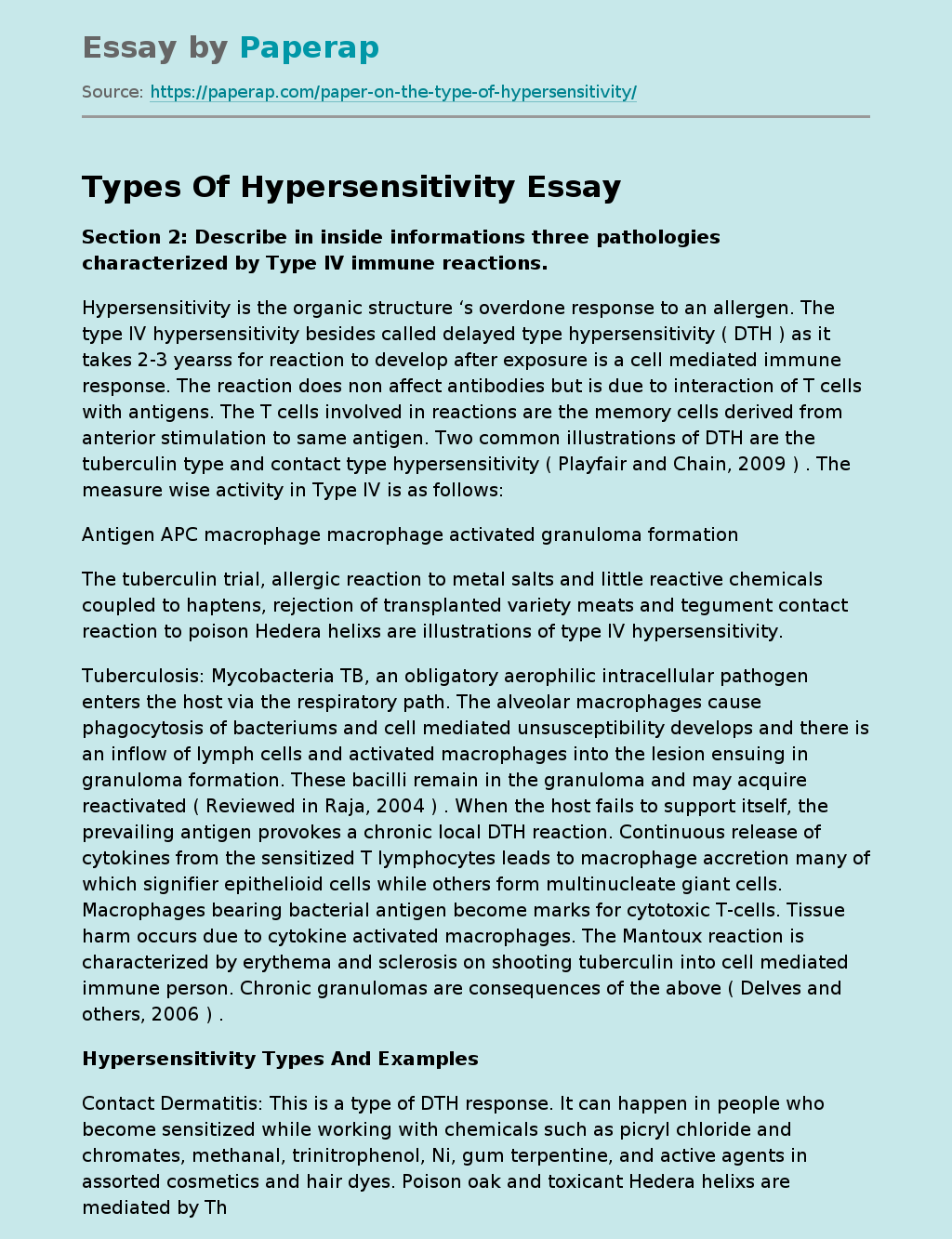Types Of Hypersensitivity
The following sample essay “Types of Hypersensitivity” provides inside information on three pathologies characterized by type IV immune responses. Among them will be considered: APC antigens, macrophages, activated macrophages and granuloma formation.
Hypersensitivity is the organic structure ‘s overdone response to an allergen. The type IV hypersensitivity besides called delayed type hypersensitivity ( DTH ) as it takes 2-3 yearss for reaction to develop after exposure is a cell mediated immune response. The reaction does non affect antibodies but is due to interaction of T cells with antigens.
The T cells involved in reactions are the memory cells derived from anterior stimulation to same antigen. Two common illustrations of DTH are the tuberculin type and contact type hypersensitivity ( Playfair and Chain, 2009 ) .
The tuberculin trial, allergic reaction to metal salts and little reactive chemicals coupled to haptens, rejection of transplanted variety meats and tegument contact reaction to poison Hedera helixs are illustrations of type IV hypersensitivity. Tuberculosis: Mycobacteria TB, an obligatory aerophilic intracellular pathogen enters the host via the respiratory path.
The alveolar macrophages cause phagocytosis of bacteriums and cell mediated unsusceptibility develops and there is an inflow of lymph cells and activated macrophages into the lesion ensuing in granuloma formation. These bacilli remain in the granuloma and may acquire reactivated ( Reviewed in Raja, 2004 ) .
When the host fails to support itself, the prevailing antigen provokes a chronic local DTH reaction. Continuous release of cytokines from the sensitized T lymphocytes leads to macrophage accretion many of which signifier epithelioid cells while others form multinucleate giant cells.
Macrophages bearing bacterial antigen become marks for cytotoxic T-cells. Tissue harm occurs due to cytokine activated macrophages. The Mantoux reaction is characterized by erythema and sclerosis on shooting tuberculin into cell mediated immune person. Chronic granulomas are consequences of the above ( Delves and others, 2006 ) .
Contact Dermatitis: This is a type of DTH response. It can happen in people who become sensitized while working with chemicals such as picryl chloride and chromates, methanal, trinitrophenol, Ni, gum terpentine, and active agents in assorted cosmetics and hair dyes. Poison oak and toxicant Hedera helixs are mediated by Th1cells. The mechanism involves the contact between the low molecular weight stuffs that are able to adhere to the peptides within the MHC channels on the surface of the Langherhans ‘ cells ( antigen showing cells ) to organize antigens. The Th1 cells sensitize to organize allergic Th1 cells. Subsequent interaction or exposure consequences in cytokine production that takes along clip. Chemical reaction is accompanied by hydrops of the cuticle with microvesicle formation. Skin testing is done to observe hypersensitivity. Patch trial is used to name patients with DTH ( Kindt and others, 2007 ; Delfs and others,2006 )
Contact sensitiveness ( CS ) , a signifier of DTH holding a T cell mediated response that occurs after exposure to haptens is characterized by subsequent leucocyte infiltration into tissue and hydrops on rhenium exposure. A survey on this was done to understand the map of mast cells and their function in contact hypersensitivity. ( Norman et al. , 2008 )
Type 1 Diabetes mellitus: It is a metabolic upset characterized by hyperglycaemia and is associated with entire or about lacking insulin due to pancreatic beta cell devastation. The pathogenesis involves the cytotoxic T lymph cell infiltration that lead to insulitis and affects the beta cells. Activated T lymphocytes cause cytokines formation ensuing in CD8+ cytotoxicity. The progresss converge towards the end of developing an antigen-specific immunotherapy for Type 1Diabetes ( Tsai et al.,2008 ) .
Drumhead: Cell mediated hypersensitivity has been demonstrated in fungous diseases such as moniliasis, dermatophytosis, coccidioidiomycosis and histoplamosis and parasitic disease leshmaniasis. Crohn ‘s disease and ulcerative inflammatory bowel disease belonging to the inflammatory intestine disease ( IBD ) exist as entities ensuing from dysregulated mucosal immune response to microbic antigens. Crohn ‘s disease is characterized by transmural granulomatous redness affecting the full wall signifier mucous membrane to serosa.
There is development of fibrosis, micro perforations, and fistulous witherss. Through out the GI piece of land redness seen. Organ specific autoimmune diseases such as type 1 diabetes, is a cell mediated hypersensitivity reaction. Psoriasis and Sarcoidosis are besides upsets of the delayed type of hypersensitivity ( James, 2000 ) . All of the above mentioned diseases show the type IV Hypersensitivity reactions.
Mention
- Delfs PJ. , Martin SJ. , BurtonDR. , Roitt IM. ( 2006 ) Roitt ‘s Essential Immunolgy. 11th ed.Blackwell publication.
- Fauci, Braunwald, et al. ( 2009 ) . Harrison ‘s Principles of Internal Medicine, 17th Ed, vol. 1, 2. McGraw Hill Medical.
- James, DG. ( 2000 ) A clinicopathological categorization of granulomatous upsets. Post grad Med Journal, 76 ( 898 ) Aug, pp. 457-465.
- Kindt TJ. , Goldsby RA. and Osborne BA. , ( 2007 ) Kuby Immunology. 6th erectile dysfunction. New York. W.H.Freeman and company.
- Norman MU. , Hwang J, Hulliger S, Bonder CS, Yamanauchi J, Santamaria P and Kubes P. ( 2008 ) Mast Cells Regulate the Magnitude and the Cytokine Microenvironment of the Contact Hypersensitivity Response. Am J Pathology,172 ( 6 ) June, pp.1638-1649.
- Playfair, JHL. And Chain, BM. ( 2009 ) Immunology at a Glance.9th erectile dysfunction. London, Wiley-Blackwell.
- Raja, A. ( 2004 ) Review article: Immunology of Tuberculosis. Indian Journal of Medical Research 120, October, pp. 213-232.
- Tsai, S. , A. Shameli, Santamaria P. ( 2008 ) . CD8+ T cells in type 1 diabetes. Adv Immunol 100, pp. 79-124.
Types Of Hypersensitivity. (2019, Dec 05). Retrieved from https://paperap.com/paper-on-the-type-of-hypersensitivity/

